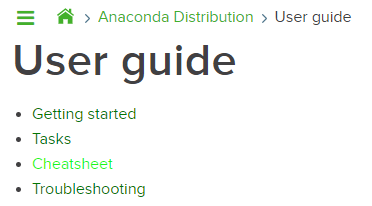- In Chapter 1, Ecosystem of Anaconda, we showed that we could go to the link https://docs.anaconda.com/anaconda/user-guide/.
- After clicking the link, we would see four entries, shown here:

- We could type conda help to find information about the usages of Conda. In Windows, click All Programs | Anaconda | Anaconda Prompt. In the Prompt, type conda help, as shown here:

- To find all packages associated with a Conda environment, we could issue the conda list command.
- Since the number of packages is quite large, a better solution is to generate a text file. We could issue conda list >c:/temp/list.txt:

- The first several lines from the output file called list.txt are shown:

- We could write an R program to read this text file:
> x<-read.csv('c:/temp/list.txt',skip=2)
> head(x)
X_ipyw_jlab_nb_ext_conf....0.1.0............py36ha9200a3_0
1 alabaster 0.7.10 py36hedafc74_0
2 anaconda 5.0.1 py36h2419598_2
3 anaconda-client 1.6.5 py36hb3b9584_0
4 anaconda-navigator 1.6.9 py36hfabed4d_0
5 anaconda-project 0.8.0 py36h88395f3_0
6 asn1crypto 0.22.0 py36hee29ec9_1
> dim(x)
[1] 380 1
- To learn how to use Jupyter, we can click Help on the menu bar after we launch Jupyter.
- From the list of entries, we can find the menu about Python and IPython and information about the Python packages called NumPy, SciPy, Matplotlib, and so on.
- After clicking on Keyboard Shortcuts, we would see the following:

To access the free support group, go to the link at https://groups.google.com/a/anaconda.com/forum/#!forum/anaconda.